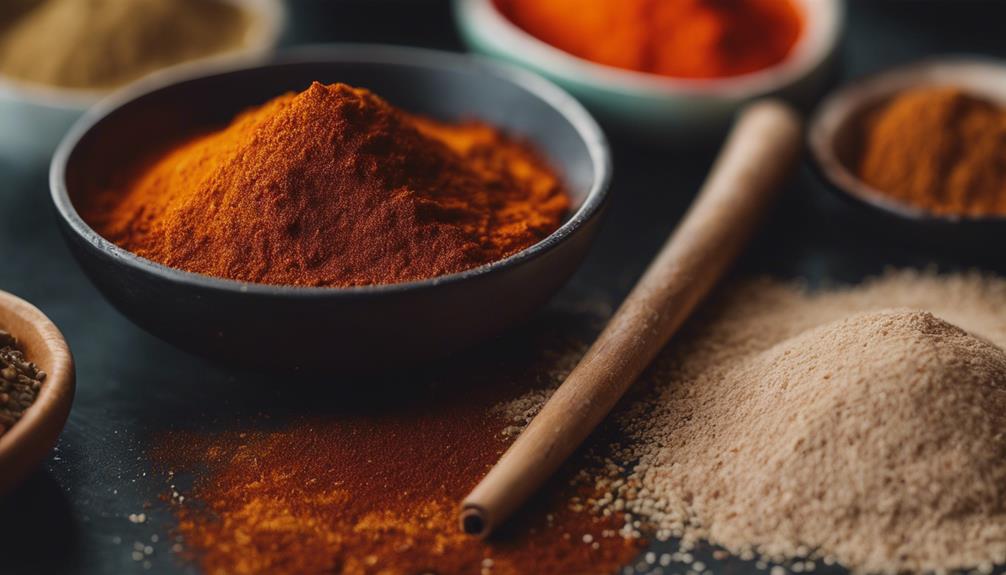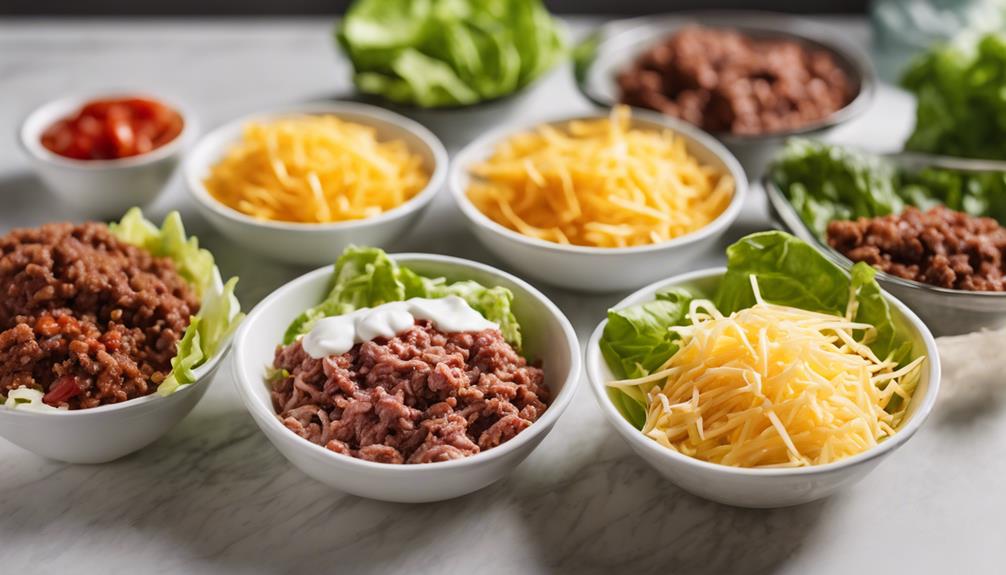Crafted with seasoned ground beef, nacho cheese sauce, and a crispy tostada shell, the homemade Crunchwrap offers a blend of flavors. Ensure the tostada shell is placed in the center of the tortilla for crunch, tightly fold, then cook in a skillet for golden edges. Serve with salsa, guacamole, or customize with vegan options. Cook until crispy on the outside. Reheat leftovers in the microwave and store in the fridge. Add fresh toppings to bring out the flavors. Be sure to refrigerate leftovers to avoid room temperature. Learn more about assembly, cooking, serving suggestions, and customization for an elevated Crunchwrap experience.
Key Takeaways
- Create a seasoned ground beef filling with a spice blend for a flavorful Crunchwrap.
- Prepare a creamy nacho cheese sauce to add richness and depth to the dish.
- Assemble the Crunchwrap with a tostada shell for crunch and fold tightly for a compact shape.
- Cook the Crunchwrap in a skillet until golden brown for a crispy texture.
- Serve with fresh salsa, guacamole, or customize with different fillings for a fun twist.
Ingredients for Crunchwrap
What're the key ingredients needed to make a delicious homemade Crunchwrap?
The essential components for crafting a mouthwatering Crunchwrap include seasoned ground beef, flavorful taco seasoning, and a large flour tortilla. These ingredients form the foundation of this beloved dish, providing a savory and satisfying base that's sure to please your taste buds.
Begin by browning the ground beef in a skillet, adding the taco seasoning to infuse it with spicy and aromatic flavors. As the meat simmers, prepare your tortilla by layering it with nacho cheese sauce, a crispy tostada shell, and a dollop of sour cream.
Once your beef is cooked to perfection, spoon it onto the tortilla and carefully fold the edges to create the iconic Crunchwrap shape.
This combination of savory beef, zesty seasoning, and warm tortilla sets the stage for a delightful culinary experience. Experiment with additional fillings like refried beans, avocado, or pickled jalapeños to customize your Crunchwrap to suit your preferences.
The result is a homemade masterpiece that's as delicious as it's satisfying.
Seasoning for Ground Beef

To guarantee your ground beef is seasoned to perfection for the Crunchwrap, consider a spice blend incorporating chili powder, ground paprika, cumin, kosher salt, and black pepper.
Cooking the beef until it's no longer pink is essential for both safety and flavor.
Remember to adjust the seasoning levels according to your taste preferences, adding more or less spice as desired.
Spice Blend Options
Consider blending chili powder, paprika, cumin, salt, and pepper to season your ground beef for a flavorful Crunchwrap. These spices, commonly found in homemade taco seasoning, work together harmoniously to enhance the taste of the beef while adding a touch of heat.
The combination of chili powder and paprika provides a smoky depth, while cumin adds a warm earthiness. Salt and pepper round out the flavors, ensuring a well-balanced seasoning profile.
Experimenting with the ratios of these spices allows you to tailor the blend to your personal preference, whether you prefer a bolder chili flavor or a more subdued cumin undertone. Achieving the right balance is essential for creating a Crunchwrap that's as delicious as the fast-food version.
Cooking Technique Tips
For a flavorful base, season your ground beef with a blend of chili powder, paprika, cumin, kosher salt, and black pepper. This combination of seasonings adds depth and richness to the meat, creating a delicious foundation for your Crunchwrap.
When cooking ground beef, make sure it's cooked thoroughly until no longer pink to guarantee it's safe to eat. Adjust the seasoning levels according to your personal taste preferences to achieve a customized flavor profile that suits your palate.
In addition to the suggested spices, consider incorporating other seasonings like garlic powder, onion powder, or red pepper flakes for an extra burst of flavor. Experimenting with different spice blends or creating your own homemade taco seasoning can offer a unique twist on traditional seasoning, elevating the overall taste of your Crunchwrap.
Making Nacho Cheese Sauce

You can create a delicious homemade nacho cheese sauce by combining butter, flour, milk, and shredded cheese in a saucepan. To elevate the flavor profile, adding spices such as chili powder, paprika, and cumin infuses the sauce with a zesty kick that pairs perfectly with the Crunchwrap Supreme.
The process of making this sauce involves cooking it over low heat, ensuring a smooth and velvety texture that enhances the overall dish. One of the benefits of crafting your own nacho cheese sauce is the ability to customize the spice level and cheese blend according to your preferences, allowing for a personalized touch to your culinary creation.
This homemade sauce offers a creamy richness that elevates the dish, making it a standout component of the Crunchwrap. Experimenting with different spice combinations and cheese varieties can lead to unique flavor profiles, enhancing your dining experience with a touch of creativity and flavor.
Crunchy Tostada Shell Assembly

Positioning a crunchy tostada shell in the center of the large tortilla is vital to add a satisfying texture to your Homemade Crunchwrap. The tostada shell serves as a sturdy foundation for the fillings, preventing sogginess and introducing a crispy element that complements the other ingredients. Placing the tostada strategically within the assembly is essential to achieving a well-balanced bite with each layer of fillings. This step is important in replicating the signature crunch of the Crunchwrap Supreme, a popular fast-food item known for its textural contrast.
Ensuring the proper positioning of the tostada is key to maintaining a structured and stable assembly when folding the tortilla around the fillings. By positioning the tostada carefully, you set the stage for a successful assembly process, allowing for a seamless integration of all components. The tostada not only adds crunch but also acts as a barrier that helps contain the fillings, enhancing the overall eating experience of your Crunchwrap.
Wrapping the Crunchwrap

When wrapping the Crunchwrap, remember to fold the tortilla layers tightly around the fillings, ensuring the edges are sealed securely to prevent any leaks.
Pleating the tortilla as you go will help keep everything inside during cooking.
Cooking the wrapped Crunchwrap in a skillet with a bit of oil will further seal and crisp up the edges, providing a delicious crunch in every bite.
Fold Tortilla Layers
Fold the tortilla edges up and over the fillings, pleating and tucking tightly to create a secure seal. This step is important in making sure that your Crunchwrap holds together beautifully during the cooking process.
Here's how to master the art of folding tortilla layers:
- Layer Ingredients: Begin by placing your seasoned ground beef, nacho cheese, tostada shell, and sour cream on a large flour tortilla. This ensures that each bite is packed with flavor and texture.
- Pleating and Tucking: As you fold the tortilla, make small pleats along the edges to create a secure seal. Tuck the fillings in tightly to prevent any spillage while cooking.
- Maintain Structural Integrity: The folding technique not only keeps the ingredients contained but also helps the Crunchwrap maintain its shape. By pressing down firmly as you fold, you guarantee that all the layers stay intact throughout the cooking process.
Seal Edges Securely
To seal the edges securely when wrapping the Crunchwrap, make sure that you fold and pleat the tortilla tightly around the fillings to prevent any spillage.
Using large flour tortillas is crucial to guarantee that you have ample space to wrap and seal the Crunchwrap effectively.
By avoiding overloading the Crunchwrap with fillings, you can avoid spills and ensure that the edges can be sealed properly.
Remember that microwaving the tortillas with a few drops of water can make them more flexible, facilitating the folding process around the fillings.
Additionally, carefully consider the size and thickness of the ingredients you're adding to make the folding process smoother and more successful.
Cooking the Crunchwrap

For cooking the Crunchwrap, begin by browning the seasoned ground beef until fully cooked.
Here are three essential steps to guarantee a delicious outcome:
- Prepare the Ingredients:
Gather the seasoned ground beef, large tortillas, and a skillet for cooking.
- Assemble the Crunchwrap:
Cut smaller flour tortilla rounds using a tostada shell as a guide to layer the ingredients on a large tortilla in a specific order.
- Cook to Perfection:
Fold and pleat the tortillas tightly, then cook the assembled Crunchwrap in a skillet until golden brown on both sides for a crispy exterior.
Serving Suggestions

Enhance the flavor and experience of your homemade Crunchwrap by pairing it with complementary side dishes. Consider serving your Crunchwrap with a side of fresh salsa or guacamole for added zest. For a satisfying crunch, accompany your meal with crispy tortilla chips. Dip these chips in leftover nacho cheese sauce or sour cream to elevate your snacking experience. To round out the flavors and create a balanced meal, serve your Crunchwrap with a side salad or coleslaw. You can enjoy your Crunchwrap Supreme as a standalone meal or add additional sides for a complete dining experience.
| Side Dishes | Description |
|---|---|
| Fresh Salsa | Adds a zesty and invigorating flavor to your meal. |
| Guacamole | Creamy and rich, perfect for dipping tortilla chips. |
| Crispy Tortilla Chips | Provides a satisfying crunch to complement your Crunchwrap. |
| Side Salad or Coleslaw | Offers a fresh and crisp contrast to the savory Crunchwrap. |
Customization Ideas

Experiment with various fillings and toppings to create a personalized and unique Crunchwrap that suits your taste preferences. Here are some customization ideas to inspire your homemade version:
- Try a Vegan Crunchwrap: Swap out traditional meat fillings for plant-based options like seasoned tofu, black beans, or meat alternatives. Add a dairy-free cheese or a cashew-based sour cream for a vegan-friendly twist.
- Go Big with a Big Mac Crunchwrap: Channel the flavors of a famous fast-food burger by incorporating special sauce, shredded lettuce, pickles, and onions into your Crunchwrap. It's a fun way to enjoy the essence of a Big Mac in a handheld format.
- Get Adventurous with Toppings: Elevate your Crunchwrap by adding unique toppings such as pineapple salsa, crispy tortilla strips, or even a drizzle of chipotle aioli. These unexpected flavors can take your homemade creation to the next level of deliciousness.
Tips for Leftovers

To make the most of your Crunchwrap experience, here are some practical tips for handling any leftovers. Reheating leftover Crunchwraps is simple and convenient; just pop them in the microwave for a top-notch meal option. For peak freshness, store any remaining Crunchwraps in an airtight container in the refrigerator. To enjoy the finest taste and texture, it's recommended to consume leftover Crunchwraps within a few days.
If you find that reheated Crunchwraps need a flavor boost, consider adding fresh toppings like lettuce, tomatoes, or salsa to revive the taste. However, be cautious not to let leftover Crunchwraps sit out at room temperature for too long to avoid the risk of foodborne illnesses.
Frequently Asked Questions
Is Taco Bell Crunchwrap Unhealthy?
Yes, Taco Bell's Crunchwrap is unhealthy with its high calorie, fat, and sodium content. Regular consumption can lead to health issues like high blood pressure. Making a homemade version lets you control ingredients for a healthier option.
How Do You Assemble a Crunchwrap at Home?
To assemble a Crunchwrap at home, start by layering seasoned ground beef, nacho cheese, tostada shell, and toppings like lettuce and tomatoes on a large flour tortilla. Carefully fold and pleat the tortilla tightly around the fillings to create a compact package.
What Comes in a Crunchwrap Meal?
In a Crunchwrap meal, you'll find seasoned ground beef, nacho cheese sauce, lettuce, tomatoes, sour cream, and a crunchy tostada shell all layered on a large flour tortilla, folded, and cooked until crispy.
What Is in the Middle of a Crunchwrap?
Nestled in the heart of a Crunchwrap lies a symphony of flavors – seasoned ground beef, gooey nacho cheese, a crispy tostada shell for that satisfying crunch, and a medley of fresh toppings. Enjoy every bite!
Can Spicy Loaded Japanese Sweet Potatoes be a Fun and Flavorful Addition to Homemade Crunchwrap?
Looking to add a fun and flavorful twist to your homemade Crunchwrap? Why not try stuffing it with spicy loaded sweet potatoes? The combination of the heat from the spices and the creaminess of the sweet potatoes will surely elevate the taste of your Crunchwrap to a whole new level.
Conclusion
So, next time you're in the mood for a fun and flavorful meal, why not try making your own homemade crunchwrap?
It's a simple and delicious dish that's sure to impress your family and friends.
Just remember, the irony of spending time assembling a DIY version of a fast food favorite is all part of the fun!
Give it a try and enjoy the delicious results.









